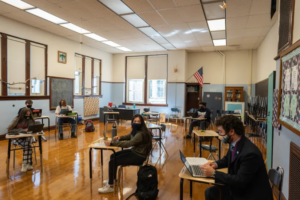As Chicago planned to reopen its school buildings for the first time since March, it surveyed prekindergarten and special education families about who planned to return. The district offered a clear escape clause: Families could always opt out.
This week, Chicago Public Schools released data that showed the majority of white families reported to school buildings as expected, while nearly half of Black families chose to stay home. About 62% of Latino students — the district’s dominant demographic — reported to campuses roughly in line with the districtwide average of 59%.
Of the 5,352 students expected to return for in-person learning, about 3,250 did.
On the heels of Chicago’s sharpest enrollment decline in two decades, the numbers signal trouble beyond the tug-of-war of remote versus in-person learning. After a year of pandemic schooling, more students are disengaging entirely.
According to the data, some students didn’t show up for either in-person learning or virtual school. In each racial group, some students didn’t come to school at all that first week: 6% of white families, 20% of Black families and 10% of Latino families.
District leaders have said for months that the district is especially concerned about drops in enrollment, attendance, and grades among its Black and Latino students. White families were more likely to sign up for in-person learning and to stick with their decision. But because the district is predominantly Black and Latino, more than 80% of students who returned to in-person learning are students of color. The district is 11% white.
In particular, officials cited steep drops in the number of prekindergarten students as helping drive their decision to phase-in reopening this year. The decline was largest among Black prekindergarten families.
“When you look at the big picture, what is most concerning is the ‘orange block,’ which is students that didn’t attend in person or online,” Chief Education Officer LaTanya McDade said, presenting the data Wednesday to the school board. That was a sign remote learning wasn’t working, she said.
“They have disengaged,” she said. “Unfortunately we see similar racial disparities across student groups.”
District data also showed how many students in vulnerable groups, such as students experiencing homelessness and students in special education, chose to return to school buildings. Of the special education students who chose in-person learning, about 59% attended in-person school, while 63% of English language learners and 40% of homeless students who signed up for in-person learning returned.
The numbers come as Chicago was forced to suspend in-person learning for the first wave of students who returned, following a labor action by Chicago teachers to defy district orders to report to campuses this week.
The racial divide in reopening has added tension to the debate about whether schools should attempt to reopen during the pandemic. It also has been a point of contention in the labor standoff between Chicago Public Schools and the teachers union, with district leaders saying reopening is an issue of racial equity and reopening critics, including union leaders, noting that a disproportionate number of white families have chosen in-person learning.
Other school districts have seen a racial divide around school reopening plans. In New York City, almost a quarter of students signed up for in-person learning were white, a disproportionate share compared with a citywide enrollment of 16% white students.
Chicago’s numbers could be a preview for what to expect when the second wave of students returns to classrooms. About 70,000 students in kindergarten to eighth grade were expected to attend in-person learning, which had been slated to start Feb. 1. With the union’s labor action, that possibility looks increasingly unlikely. According to initial survey results, the second wave of students was also disproportionately white. The district has about 340,000 students total; high schools don’t have a plan to return to in-person learning.
The labor negotiations could risk shifting that timeline and, and the ongoing uncertainty, also could push some families to stay remote.
Chicago has seen fewer prekindergarten and special education students attending in-person school than it anticipated, which was likely impacted by several factors.
Families were given the option of signing up for in-person learning but switching back to hybrid at any point. But the opposite was not true, which gave some families incentive to choose in-person learning. Reports of a new COVID-19 variant appearing in Illinois also coincided with the return this month.
Black and Latino communities, particularly those with a large number of residents who must work outside the home, have been hardest hit by the coronavirus pandemic. About 30% of Chicago’s residents are Latino and 30% Black, while about 38.7% of the city’s coronavirus deaths were among Black people and 33.9%among Latinos.
In the first months of the pandemic, Black and Latino students were more likely to receive “incomplete” grades than white peers. And even before COVID-19, Chicago’s Black students had backslid on a closely watched metric that predicted which ninth graders are most likely to graduate, highlighting a district need for more support for Black students.
The students who were absent the first week are part of a broader group, estimated at 6,900 students in the first weeks of remote learning, that failed to log into classrooms. In the fall, officials promised new protocols to find missing students, including tens of thousands of phone calls to vulnerable students, a mass flyering campaign led by Safe Passage workers, and security guards trained for home visits.
Chalkbeat is a nonprofit news site covering educational change in public schools.
The article was originally posted at A troubling trend in Chicago’s school reopening: More students disengaged






Be First to Comment